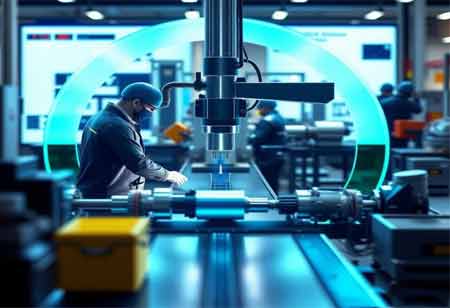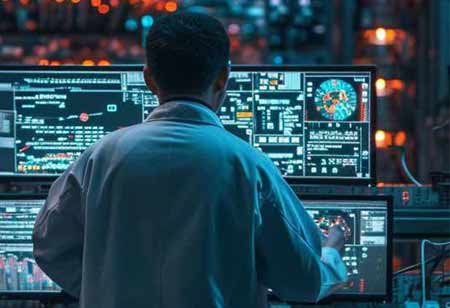THANK YOU FOR SUBSCRIBING

A Vision For The Future: Automation, Robotics, And The Smart Factory
Joe Tilli, State Industrial Automation Sales Manager, Lawrence & Hanson

 Joe Tilli, State Industrial Automation Sales Manager, Lawrence & Hanson
Joe Tilli, State Industrial Automation Sales Manager, Lawrence & HansonJoe Tilli strongly believes in automation and its evolving concept of smarter electronics with higher temperature ratings and extended life cycles. He utilizes advanced automation technology to monitor and enhance various industrial processes.
In an exclusive interview with Applied Technology Review APAC, he shared his invaluable insights on the role of smart automation in the industry and the ensuing challenges.
Journey In Automation
I have extensive experience working with major OEMs and end users. The automation sector plays a significant role in industries like food and beverage manufacturing, where companies such as Coca-Cola, Goodman Fielder (which produces much of Australia’s bread), and Kraft Foods heavily rely on automation.
When I started in 1988–89, automation was not widely adopted. It was almost a foreign concept. Most manufacturing processes were manual, with tasks divided among multiple workers. For example, on a production line, one person might move a box, another would check its size, and so on.
However, by the mid-2000s, automation became a gamechanger, making factory operations more efficient and costeffective. Instead of needing 15 people on a line, automation reduced the requirement to just two or three, significantly improving productivity.
Over the past 20 years, automation has continued to grow, and today, robotics is a major part of the industry. While robots are highly efficient—performing repetitive tasks without fatigue— they require significant space, which can be a limitation. Pickand-place robots, for instance, can replace human labor by quickly and precisely moving parts from one section to another, operating seamlessly within programmed parameters.
As for my career, I started as an electronics technician before transitioning into electronics surveying. In 2000, I moved into automation technical sales, where I have remained ever since.
The Rise Of Just-In-Time Manufacturing In Industrial Automation
One of the key trends in the industrial automation space today is the widespread adoption of Just-in-Time (JIT) manufacturing by large companies.
When developing a new product, companies typically go through several stages—engineering, design, CAD modeling, and prototyping. Before full-scale production begins, they test the system on a smaller scale to ensure it functions properly. The primary goals for these companies are increased product output, lower operational costs, minimal maintenance, and advanced fault detection. Automation plays a key role in achieving these objectives.
“The Success Of Automation Depends On How Well A Company Aligns Its Technology Strategy With Its Production Needs. Organizations Should Ensure They Have The Right Infrastructure, Smart Devices, And Automation Capabilities In Place To Optimize Output, Reduce Costs, And Increase Efficiency”
For example, consider a production line that stacks boxes of books. If an error occurs—such as an empty box making it through the line—an automated system can detect the issue, stop the process, and send a report to a central operator interface. This interface provides real-time data on production efficiency, highlighting losses, gains, and overall performance.
Ultimately, companies seek low-maintenance, high-output, and cost-effective automation solutions that improve efficiency and reduce manual intervention.
Smart Automation For Augmenting Efficiency
Modern factory automation centers on a wireless hub that integrates Programmable Logic Controllers (PLCs). A programmer configures these PLCs with input and output instructions, enabling them to control machinery down to the millisecond. All data from these systems is sent back to a single hub, which can be monitored by a maintenance manager, a project design team, or other overseeing personnel.
Smart technology enhances efficiency, particularly through variable speed drives (VSDs), which control conveyor belt motors. Most factories have 10 to 20 motors, with some exceeding 70. Unlike older systems that ran at full power all day—wasting energy—VSDs adjust motor speed based on demand. Previously, motors ran needlessly due to the lack of manual intervention. Now, smart automation automatically stops or slows motors, cutting energy costs and reducing wear and tear.
Discrete electronics have also evolved to withstand extreme factory conditions. Older components struggled in high heat, often failing within two years despite a five-year lifespan claim. Today’s semiconductors handle -15°C to 100°C (5°F to 212°F), ensuring greater durability and reliability.
Overall, the industry is shifting towards smart devices, energy-efficient components, and advanced PLC systems. These technologies automate decision-making, such as adjusting conveyor belt speeds or stopping production at specific points, reducing the need for manual intervention while optimizing energy use and system longevity.
A Vision For The Future
The industrial automation sector is becoming increasingly advanced and efficient, with smart devices and robotics playing a larger role. However, many factories still rely on older systems due to budget constraints or capital expenditure limitations, preventing them from fully transitioning to automation.
A fully automated facility, such as a modern warehouse, requires minimal human intervention. With the right programming, a single operator can oversee an entire operation— managing packing, part movement, and logistics—all handled by smart devices.
Traditionally, industrial robots were large, rigid machines with extended arms performing repetitive pick-and-place tasks. Now, modern robotics is becoming more sophisticated, integrating machine vision and AI. For example, robots can now differentiate between colors, identify green and red objects, and place them in designated areas based on programmed instructions.
While we may not see drastic changes in the next 18 to 24 months, there will be a steady increase in automation adoption, with more factories implementing smart technology and robotics to enhance efficiency, accuracy, and cost-effectiveness.
My key advice to peers, in this regard, would be to start with risk assessment and a product function analysis for the company. The key question is what do you want to achieve? Do you envision a fully automated factory where operations run seamlessly at the press of a button, only changing when a new command is given?
This approach involves recipe analysis, where specific production schedules are pre-programmed. For example, companies can implement automated scheduling through recipe analysis, where specific processes run at designated times. A conveyor system could be programmed to stop at 11:00 AM and switch to a second production line at 11:30 AM, operating until noon. This level of automation helps optimize productivity with minimal manual adjustments.
Larger manufacturers, like Coca-Cola or Kraft Foods, deal with thousands of inputs and outputs, making advanced automation essential. Many of these companies are now using dynamic PLC analysis, which allows the system to adapt in realtime based on demand. The system, which is computer-driven, can determine that 10,000 cans of Coke are needed today, but only 2,000 cans are required on Wednesday. This self-regulating capability ensures efficiency and adaptability in production.
In the end, the success of automation depends on how well a company aligns its technology strategy with its production needs. Organizations should ensure they have the right infrastructure, smart devices, and automation capabilities in place to optimize output, reduce costs, and increase efficiency.
Read Also






















ON THE DECK